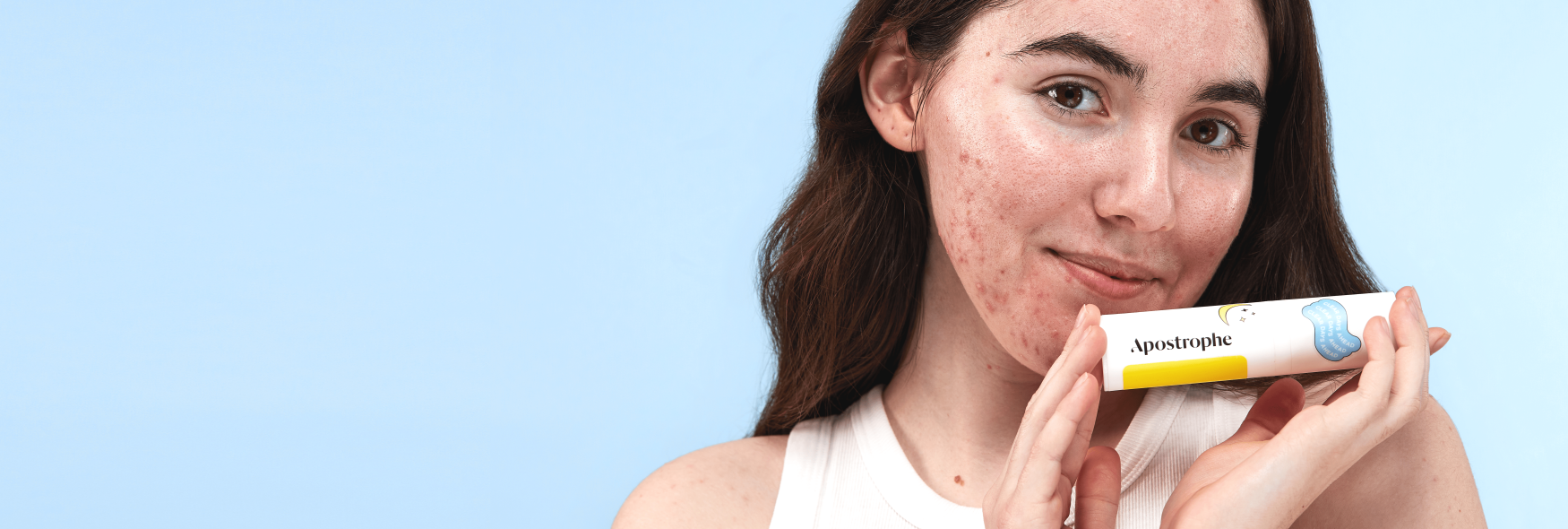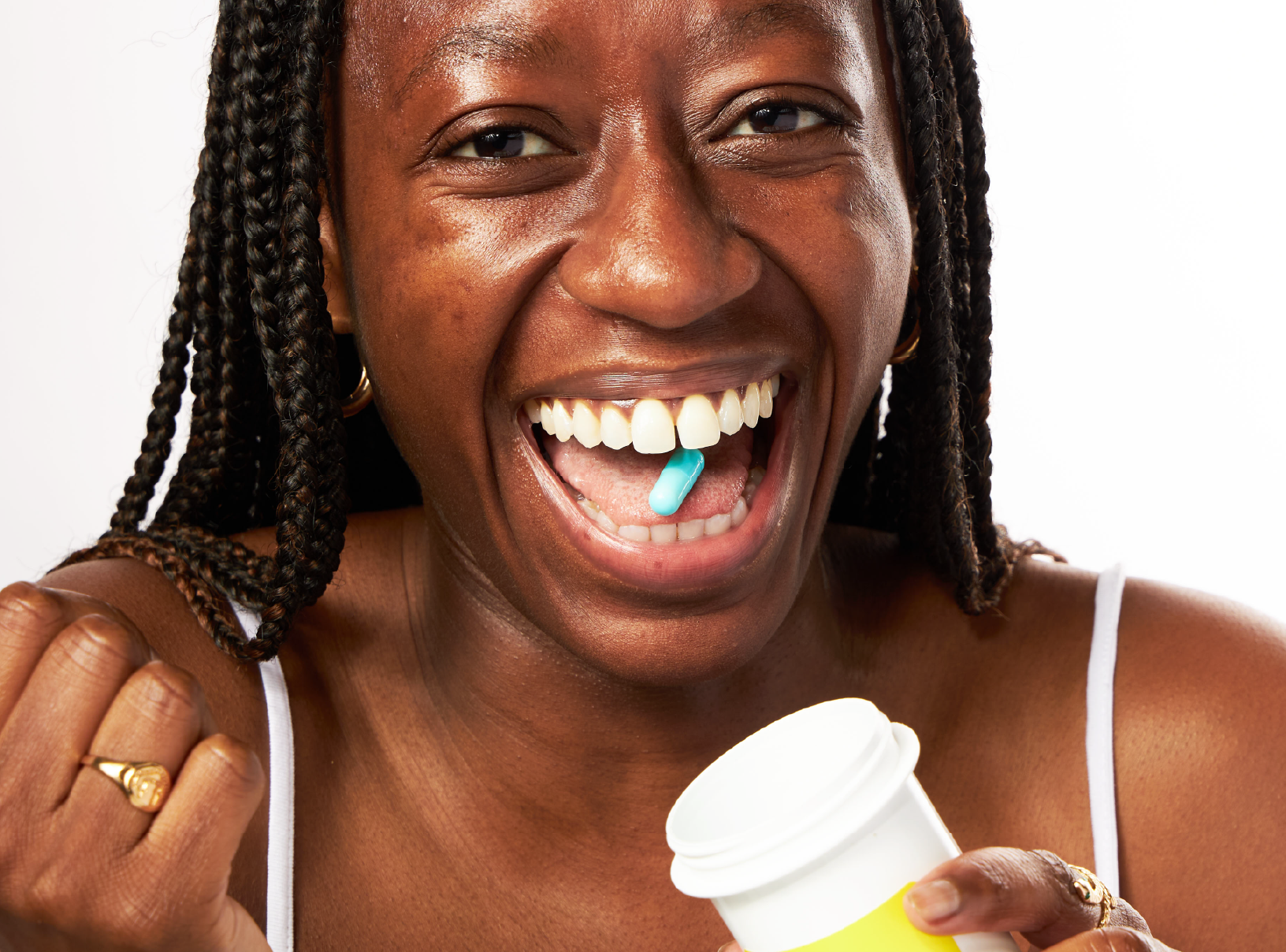Education
How to get rid of red pimples


SHARE
Education
How to get rid of red pimples
Medically reviewed by Kristin Hall, FNP
Written by Apostrophe Team
Last updated 11/3/2024
Here’s a scenario just about everyone has dealt with: you wake up in the morning. Then, perhaps you pour yourself some coffee or scroll through social media before heading into the bathroom to get ready for the day.
That’s when you see it: a big, honking red pimple that you’re fairly certain the astronauts can see from space.
For the rest of the day, the only thing you can focus on is that mild acne blemish and how the heck to get rid of it.
Even though they can definitely be a bit of an eyesore — especially to the more self-conscious among us — there are things you can do to get rid of red pimples.
But first, learn a bit more about these facial foes.
What Causes Red Pimples
Pimples happen when a combo of sebum and dead skin cells mingle together to cause a blockage in your pores and hair follicles.
This buildup can lead to inflammation, which is why your zits may look red and angry.
In case you don’t know, sebum is the oil-like substance produced by your sebaceous glands to lubricate your skin and hair — and also protect your skin from bacteria and environmental factors.
A variety of things can cause excess sebum production, and thus, oily skin. A common cause is hormone imbalances — like the ones that occur during your period.
Genetic factors can also contribute to acne breakouts in the same way environmental elements can.
Doing things like not washing your face after a workout or even cleansing your face too often can lead to pimples.
Wondering how dead skin cells play a role? During a process called epidermal turnover, your body naturally sheds dead skin cells every 40 to 56 days to renew and replace the skin.
When sebum and these dead skin cells do the tango, it can block pores and leave you with the skin condition we all know as acne.
Lifestyle choices like smoking and sleeping with makeup on can also lead to acne breakouts.
The Golden Rule
If you’re trying to get rid of that redness, it’s tempting to do some squeezing, but trust us when we tell you: don’t. Do not.
When you squeeze a pimple, some of the acne-causing bacteria may come out, but you may also push some of it deeper — and that can make the pimple worse and may cause scarring.
Popping can also spread bacteria to other pores, creating even more zits.
Visit a board-certified dermatologist who’s trained to drain a zit. If they determine that a pimple needs popping, they should be the ones to do it.
Your dermatology provider may also be able to inject the site with a corticosteroid injection to reduce redness-causing inflammation and expedite healing.
Dealing With Red Pimples
There’s not just one way to deal with unsightly zits. There are actually a number of effective strategies you can employ to get rid of your acne as quickly as possible. They include:
Topical Treatments
Topical treatments are not only quite popular, but can also be very effective.
Benzoyl peroxide and salicylic acid are two of the most well known topicals. The first eradicates pore-clogging dead skin cells and attacks the breakout-inducing bacteria.
It can cause irritated skin, so use it with caution.
Salicylic acid reduces swelling, which can help reduce redness. It also removes dead skin cells to help clear the infected pore and allow the pimple to clear up.
A retinoid can also be used as a topical to treat red pimples. These unclog pores by preventing dead skin cells from building up.
Then, there’s tretinoin, a type of retinoid that’s only available with a prescription. It works by encouraging skin to shed dead skin cells that cause breakouts.

PRESCRIPTION TRETINOIN
Target acne, dark spots, and signs of aging with this science-backed ingredient.
Clindamycin is a prescription antibiotic that slows or stops bacteria from multiplying.
Similarly, azelaic acid destroys bacteria to help inhibit the growth of blemishes.
Often, you’ll see a few of these ingredients combined in skin care products to create one topical that really works for your skin type.
Oral Medication
If red spots are a regular thing for you, oral medication may be required. Birth control pills and Isotretinoin are two options often prescribed.
A handful of combined oral contraceptives have been approved by the FDA for use in acne treatment.
They work by lowering your levels of certain hormones (like testosterone) and reducing sebum production.
Isotretinoin also works by reducing sebum production, but it does more than that—it also prevents dead skin cells from building up.
Occasionally, a healthcare professional may also prescribe an oral antibiotic to prevent bacteria from multiplying, but this route is usually only pursued in the case of severe or cystic acne.
Light Therapy
Fight red zits with red or blue light therapy for acne. You can make an appointment at a dermatology office or med spa, or buy an at-home device to give your skin this treatment that can help get rid of pimples.
It may sound funny, but red light actually diminishes redness by soothing inflammation and repairing tissue damage caused by acne.
Blue light therapy can help with redness too, while also killing the bacteria that causes pimples.
DIY Treatments
There are a few other easy things you can do at home. They may not totally get rid of the pimple, but they can help with the redness.
First up? Ice! Applying ice can reduce redness-causing inflammation.
You should also avoid touching your face or picking at your skin. Touching can transfer more bacteria to your face and make acne worse, and picking can cause even more damage.
Aside from that, while there’s no concrete evidence out there that your diet may contribute to acne breakouts, there’s some to suggest that a low-glycemic index diet may help.
Low glycemic index foods include things like oatmeal, nuts, beans, leafy greens, and other non-starchy veggies, etc.
Staying hydrated is also a super important factor in skin health, and while it may not necessarily help eliminate acne, it certainly can’t hurt. So, drink more water.
Bye-Bye, Redness!
To be blunt, zits suck — especially when they’re super red and hard to hide.
Thankfully, there are a variety of treatment options out there to deal with the clogged pores that cause blemishes.
From over-the-counter topicals that contain benzoyl peroxide or other active ingredients to prescription medications and beyond, getting rid of redness is possible.
To investigate further, speak with a licensed dermatology provider and discuss what acne treatment may be best for you.
Sources:
Acne (2012). Retrieved from https://www.womenshealth.gov/a-z-topics/acne
Makrantonaki, E, Ganceviciene, Zouboulis, C (2011, Jan-March). An update on the role of the sebaceous gland in the pathogenesis of acne. Dermato Endocrinology. 3(1), 41-49. Retrieved from https://www.ncbi.nlm.nih.gov/pmc/articles/PMC3051853/
Koster, M.I. (2009, July). Making an epidermis. Annals of the New York Academy of Sciences. 1170, 7-10. Retrieved from
Zeichner, J. A., Baldwin, H. E., Cook-Bolden, F. E., Eichenfield, L. F., Fallon-Friedlander, S., & Rodriguez, D. A. (2017). Emerging Issues in Adult Female Acne. The Journal of clinical and aesthetic dermatology, 10(1), 37–46.retrieved from https://www.ncbi.nlm.nih.gov/pmc/articles/PMC5300732/
Pimple Popping: Why Only Dermatologists Should Do It. American Academy of Dermatology. Retrieved from https://www.aad.org/public/diseases/acne/skin-care/popping|
Benzoyl Peroxide Topical. Medline Plus. Retrieved from https://medlineplus.gov/druginfo/meds/a601026.html
Salicylic Acid Topical. Medline Plus. Retrieved from https://medlineplus.gov/druginfo/meds/a607072.html
Acne: Diagnosis and Treatment. American Academy of Dermatology. Retrieved from https://www.aad.org/public/diseases/acne/derm-treat/treat
Azelaic Acid Topical (2016, December, 15)l. Medline Plius. Retrieved from https://medlineplus.gov/druginfo/meds/a603020.html
Salvaggio, H.L. & Zaenglein, A.L. (2010). International Journal of Womens Health. 2, 69–76. Retrieved from
Baldwin, H. (2020). Oral Antibiotic Treatment Options for Acne Vulgaris. The Journal of Clinical and Aesthetic Dermatology. 13 (9), 26–32. Retrieved from
Pei, S., Inamadar, A, Adya, K., Tsoukas, M., (2015, May-June). Light-based therapies in acne treatment. Indian Dermatology Online Journal, 6(3): 145–157. Retrieved from https://www.ncbi.nlm.nih.gov/pmc/articles/PMC4439741/
Burris J, Shikany JM, Rietkerk W, Woolf K. A Low Glycemic Index and Glycemic Load Diet Decreases Insulin-like Growth Factor-1 among Adults with Moderate and Severe Acne: A Short-Duration, 2-Week Randomized Controlled Trial. J Acad Nutr Diet. 2018 Oct;118(10):1874-1885. Retrieved from: https://pubmed.ncbi.nlm.nih.gov/29691143/ Epub 2018 Apr 22. PMID: 29691143
Palma, L., Marques, L. T., Bujan, J., & Rodrigues, L. M. (2015). Dietary water affects human skin hydration and biomechanics. Clinical, cosmetic and investigational dermatology, 8, 413–421. Available from https://www.ncbi.nlm.nih.gov/pmc/articles/PMC4529263/
Like what you just read? Sign up for our email list to get the scoop on skincare science delivered straight to your inbox.

Deep Dives
A dermatologist shares his thoughts on the recent studies about benzoyl peroxide and benzene.
Read More
Education
What is milia?
What is milia? Today, we’re jumping into one type of bump that you may have heard about most commonly in infants — milia.
Read More
Education
Best moisturizer for acne-prone skin
If you have combination acne-prone skin, figuring out which moisturizer is best for your skin might be tough. In this guide, we break down the best moisturizer for combination, acne-prone skin.
Read More